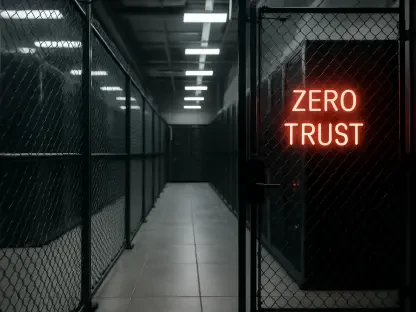In an era where digital operations are the backbone of nearly every industry, the reliance on IT infrastructure has never been more critical, yet it exposes businesses to the devastating risk of cascading outages that can halt operations in mere moments. A striking incident in June demonstrated this vulnerability when a minor glitch in Google Cloud unleashed a chain reaction, disrupting interconnected services like Cloudflare and affecting a vast array of consumer apps, business tools, and developer platforms. This event wasn’t just a technical hiccup; it revealed the fragile underbelly of an interconnected IT ecosystem where a single failure can ripple across sectors. The urgency for businesses to shield themselves from such disruptions has never been clearer, as the consequences extend far beyond immediate downtime to long-term financial and reputational damage. Exploring the root causes of these outages and identifying robust strategies to mitigate their impact is essential for any organization aiming to thrive in today’s digital landscape.
Understanding the Risks of IT Consolidation
The Fragility of Interconnected Systems
The interconnected nature of modern IT infrastructure, while enabling seamless global operations, often becomes a double-edged sword during cascading outages, as evidenced by the June incident involving Google Cloud. When a seemingly small bug triggered widespread failures, it didn’t just affect one provider but brought down services like Cloudflare, which in turn disrupted countless applications and platforms relied upon by businesses and consumers alike. This domino effect showcases how dependent major providers are on each other for critical functionalities, creating a web of vulnerabilities. A single point of failure in this tightly knit system can lead to disruptions that span industries, from entertainment to enterprise solutions. The scale of impact is staggering, as businesses of varying sizes find their operations grinding to a halt without warning, exposing the inherent risks of an ecosystem where interdependencies amplify rather than mitigate potential failures.
Beyond the immediate technical disruptions, the financial and operational consequences of such outages paint a grim picture for businesses caught unprepared in this digital quagmire. Direct losses, such as missed advertising revenue for streaming platforms, can be calculated with some accuracy, but the hidden costs often prove far more insidious and difficult to measure. Consider a startup unable to deliver a pivotal investor presentation due to downed services, or a consulting firm missing out on a revenue-generating webinar because of inaccessible tools. These lost opportunities, coupled with potential damage to brand reputation, can have lasting effects that outstrip immediate monetary losses. For organizations entirely dependent on a single IT provider, the stakes are even higher, as they lack the fallback options needed to weather such storms, underscoring the urgent need to reassess reliance on concentrated infrastructure models.
The Domino Effect on Business Continuity
Cascading outages do more than just interrupt service; they expose systemic weaknesses that can undermine business continuity across multiple sectors with alarming speed. The June failure wasn’t an isolated event but a symptom of a broader issue where the consolidation of IT services into a few major players creates a fragile environment ripe for widespread disruption. When core services falter, the ripple effects can disable everything from customer-facing apps to internal business tools, leaving companies scrambling to maintain operations. This interconnected fragility means that even small enterprises, which may not directly contract with affected providers, can suffer due to dependencies on third-party services. The resulting downtime often translates into customer dissatisfaction and eroded trust, which can take months or years to rebuild, highlighting a critical flaw in over-centralized systems.
Moreover, the unpredictability of these outages compounds their impact, as businesses often lack the foresight or resources to prepare for sudden, large-scale disruptions originating from external providers. Unlike localized issues that can be managed internally, cascading failures stemming from major cloud platforms are often beyond a company’s control, leaving them at the mercy of resolution timelines set by others. This loss of agency during crises can stall critical operations, delay product launches, or disrupt customer service, each carrying significant economic penalties. The broader lesson from such incidents is that reliance on a singular, dominant infrastructure can turn a minor glitch into a major catastrophe, pushing businesses to rethink how they structure their digital foundations to avoid being caught in the crossfire of systemic failures.
Challenges with Public Cloud Dependency
Limitations of Scalability and Support
The allure of public cloud providers like Google Cloud, AWS, and Azure lies in their promise of scalability and flexibility, yet this very dependency reveals significant vulnerabilities when outages strike, as seen in the June disruption. While these platforms enable businesses to expand operations rapidly without heavy upfront investments, they are not immune to failure, and their vast, complex systems can be prone to errors that ripple outward. Configuring redundancy within these environments often proves challenging, as it requires technical expertise that many organizations lack, leaving them exposed when disruptions occur. The assumption that public clouds are inherently reliable is a dangerous misconception, as even the largest providers can falter under unexpected conditions, forcing businesses to grapple with unplanned downtime that can cripple operations at critical junctures.
Compounding the technical risks is the glaring lack of personalized support and communication from these hyperscalers, particularly evident during crisis situations like the June outage. When Google Cloud’s own systems went offline, users were left without updates for an hour, amplifying confusion and frustration at a time when clarity was most needed. This delay in communication isn’t just an inconvenience; it hinders businesses from making informed decisions about mitigating damage or switching to backup plans. Even in non-emergency scenarios, many companies find it difficult to secure tailored assistance despite significant investments in cloud services. This gap in customer service reveals a critical flaw in the public cloud model, where scale often comes at the expense of direct, responsive support, leaving businesses feeling isolated when they most need a lifeline.
Barriers to Effective Crisis Management
Navigating the aftermath of an outage in a public cloud environment often exposes additional barriers that hinder effective crisis management for businesses reliant on these platforms. The sheer scale of hyperscalers means that individual clients, even those with substantial contracts, can struggle to get prioritized attention during widespread disruptions. Unlike smaller, more agile providers, large cloud giants operate on a model that prioritizes mass service over individualized problem-solving, which can delay resolution times for specific issues. This one-size-fits-all approach often leaves companies without the immediate tools or guidance needed to address downtime, forcing them to absorb losses while waiting for systemic fixes that may not align with their urgent timelines.
Furthermore, the complexity of public cloud architectures can create internal challenges for businesses attempting to manage crises independently, as many lack the in-house expertise to troubleshoot or implement workarounds effectively. Misconfigurations or misunderstandings of redundancy protocols can exacerbate outages, turning a temporary glitch into a prolonged disruption with cascading effects on operations. The absence of direct, hands-on support from providers during these moments often means businesses must rely on generic documentation or community forums, which may not address unique needs or time-sensitive problems. This disconnect highlights a fundamental limitation in depending solely on public cloud solutions, pushing the conversation toward strategies that offer greater control and responsiveness in the face of inevitable technical failures.
Embracing Hybrid Infrastructure as a Solution
Diversifying Workloads for Resilience
Adopting a hybrid infrastructure presents a compelling strategy for businesses aiming to shield themselves from the risks of cascading IT outages by diversifying workloads across multiple environments. This approach involves distributing operations between public clouds, private clouds, and colocated servers, tailoring hosting solutions to the specific demands of each workload. For instance, experimental or rapidly scaling projects might leverage the flexibility of public clouds, while mission-critical applications could benefit from the enhanced control and security of private setups. By avoiding over-reliance on a single provider or system, companies can minimize the impact of a failure in one area spreading to others, creating a more robust digital foundation that withstands disruptions with greater ease and ensures continuity even under adverse conditions.
In addition to workload distribution, hybrid models empower businesses to design redundancy and failover strategies that align with their unique risk profiles and operational priorities. This might involve maintaining local backups for quick recovery or establishing global failovers to switch operations seamlessly during an outage. Such flexibility allows organizations to balance cost, performance, and reliability in ways that a singular public cloud setup often cannot accommodate. The strength of this diversified approach lies in its ability to prevent a single point of failure from derailing entire operations, offering a safety net that can preserve customer trust and revenue streams. As businesses navigate an increasingly complex digital landscape, hybrid infrastructure stands out as a pragmatic way to build resilience without sacrificing the advantages of modern cloud technologies.
Leveraging Managed Service Providers
Managed service providers (MSPs) play a pivotal role in enhancing the effectiveness of hybrid infrastructure, addressing the support gaps often experienced with large public cloud providers. By offering expert guidance on workload placement, migration, and optimization, MSPs combine the hands-off convenience of public clouds with the personalized attention reminiscent of traditional on-premises systems. This tailored assistance ensures that businesses can navigate the complexities of a hybrid setup without needing extensive in-house expertise, allowing them to focus on core operations rather than technical intricacies. During disruptions, MSPs can act as a critical lifeline, providing rapid response and customized solutions that hyperscalers often fail to deliver, thus minimizing downtime and its associated costs.
Equally important is the strategic advantage MSPs bring to long-term planning and risk management within a hybrid framework, helping businesses stay ahead of potential vulnerabilities. They can assess specific needs and recommend configurations that optimize both performance and redundancy, ensuring that critical systems remain operational even when parts of the infrastructure falter. This proactive approach contrasts sharply with the reactive nature of dealing with public cloud outages, where resolution often depends on the provider’s timeline. By partnering with MSPs, companies gain access to a level of adaptability and stability that fortifies their digital operations against unpredictable failures. Reflecting on past disruptions, it’s evident that such partnerships have proven instrumental in helping businesses maintain continuity, underscoring their value as a cornerstone of resilient IT strategies moving forward.









